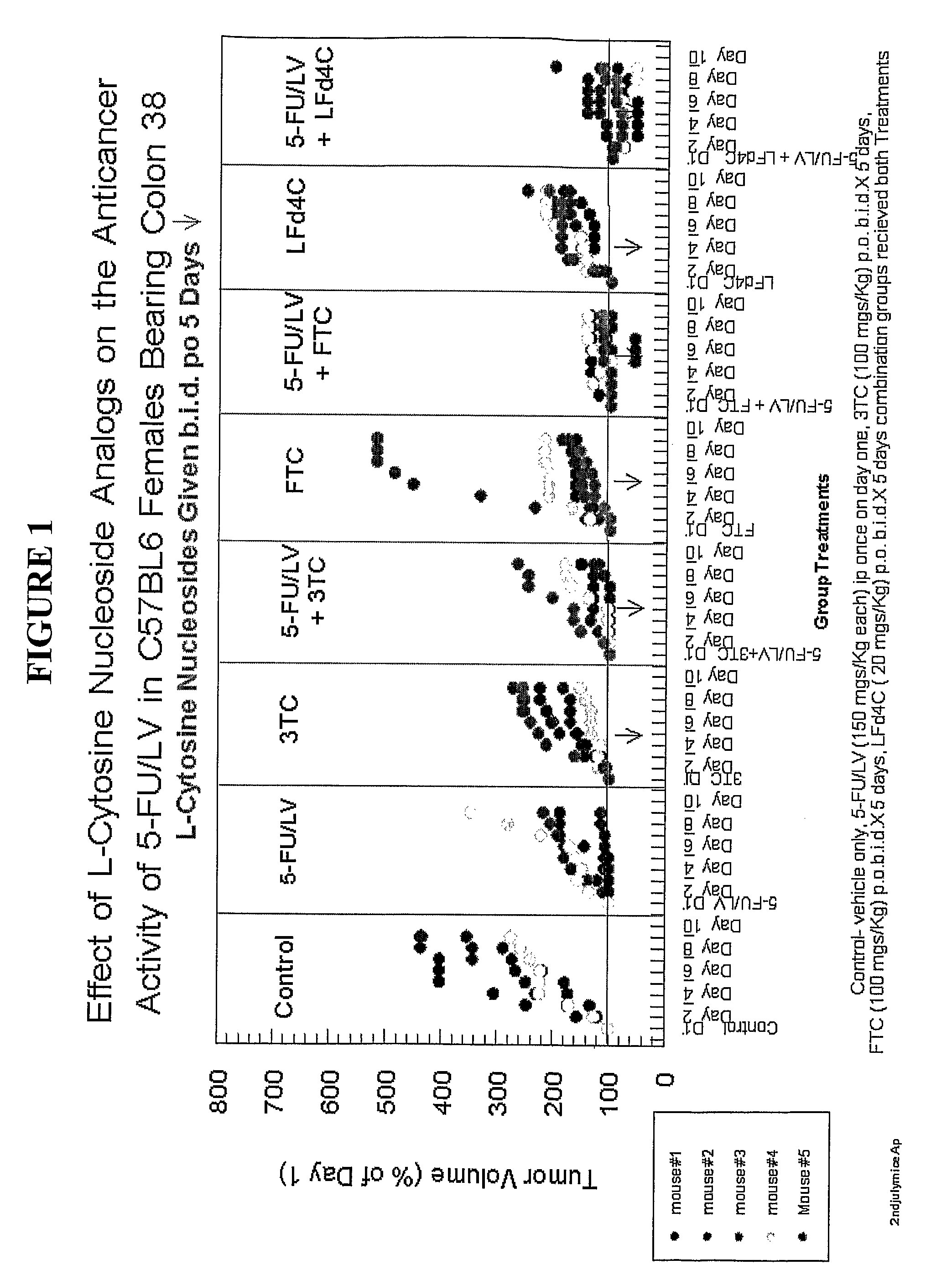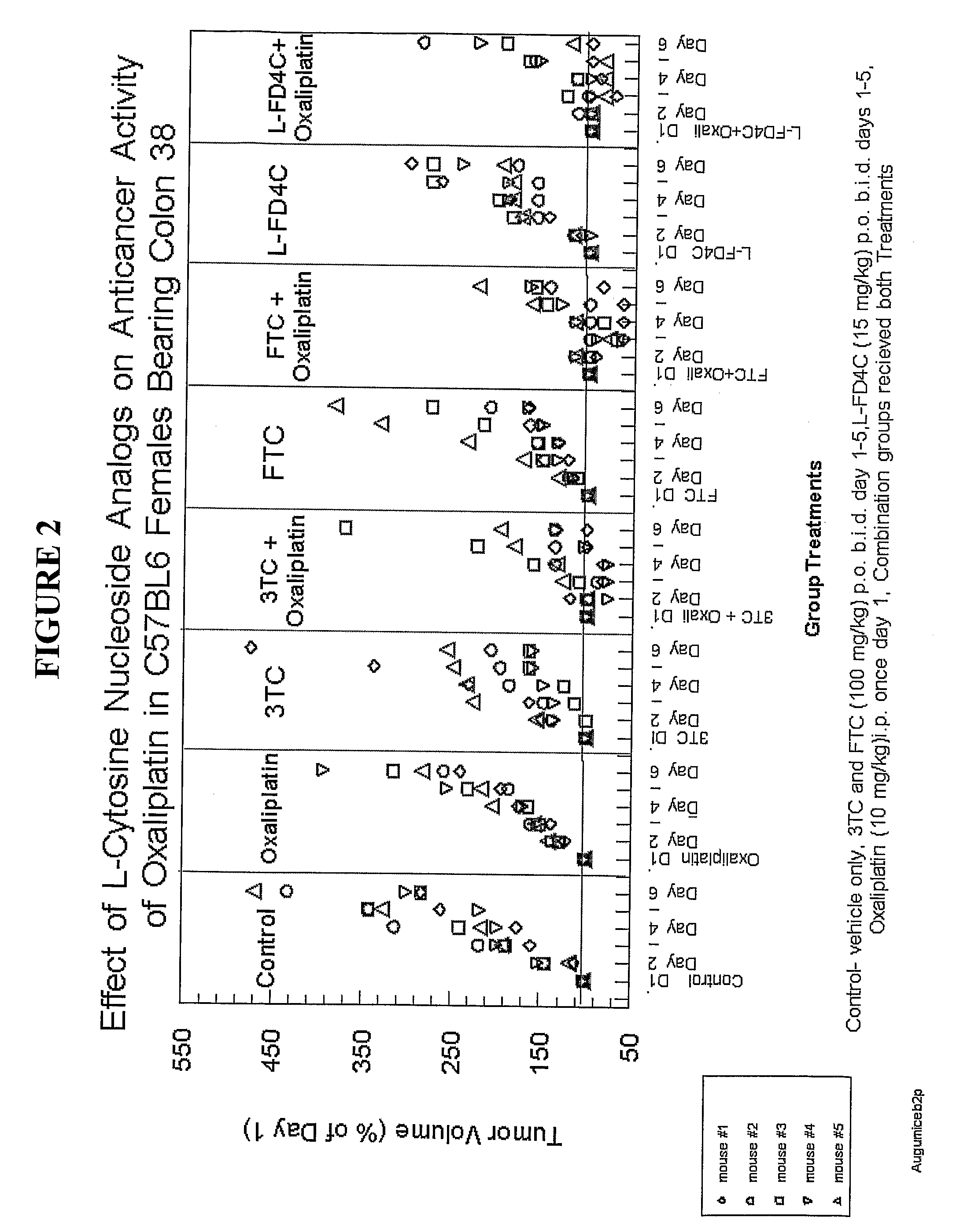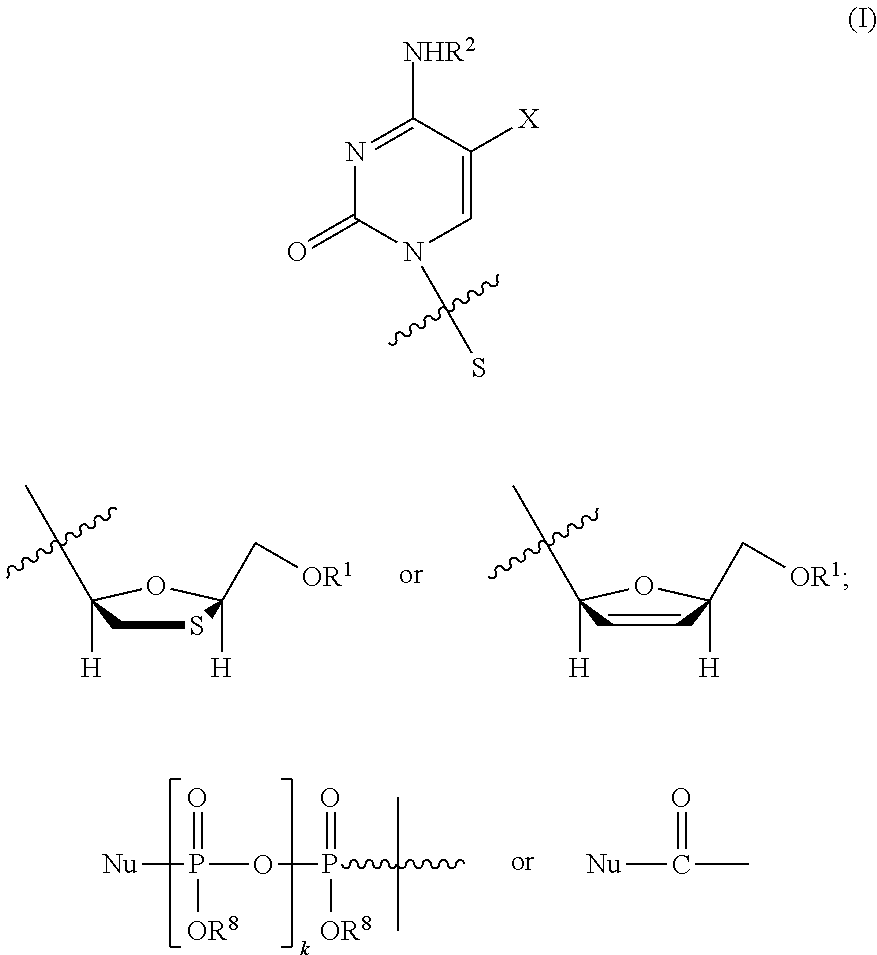Method of treating cancer and other conditions or disease states using L-cytosine nucleoside analogs
a technology of cytosine and nucleosides, applied in the field of treating cancer and other conditions or disease states using l-cytosine nucleoside analogs, can solve the problems of inability to use in the treatment of tumors located in other areas such as the backbone, inability to control cell growth, and inability to treat disseminated neoplastic conditions such as leukemia
- Summary
- Abstract
- Description
- Claims
- Application Information
AI Technical Summary
Benefits of technology
Problems solved by technology
Method used
Image
Examples
examples
[0149]In these examples, the subject of the present invention, 3TC, FTC or LFD4C are used to determine the effect on tumor growth in a number of strains of mice.
[0150]In general, the following protocol was used to implant mice with tumor cell lines and to test drugs for the anti-cancer effect.
[0151]Passage of Colon 38:
[0152]This tumor is passed from a solid tumor growing in mice. Several grams (assuming a gram per ml) are pressed through a sterile screen and suspended in a tissue culture media without phenol red or fetal calf serum (a balanced salt solution) at 2 ml / gram of tumor. Then 0.1 ml of this tumor suspension is implanted into the flank of the mouse. Ten days to two weeks after implantation (when the tumors could be measured with a caliper), unless otherwise indicated, the drug therapy was initiated.
[0153]In general, drugs are delivered according to the following schedule. Every day the mice are weighed to deter the amount to be injected and as an index of toxicity.
[0154]The...
experiment 1
[0155]This experiment was designed to determine the effect of 3TC, FTC or LFD4C alone and in combination with 5-Fluorouracil with leucovorin rescue on the growth of mouse tumor (colon 38) in immuno-competent mice. The drugs were administered to the mice according to the following schedule:
[0156]Control—vehicle only;
[0157]5FU / LV—150 mg / kg each i.p. once on day one
[0158]3TC—100 mg / kg p.o. b.i.d. for 5 days
[0159]FTC—100 mg / kg p.o. bid for 5 days
[0160]LFD4C—20 mg / kg p.o. b.i.d. for 5 days
[0161]Combination groups received both treatments as per above schedules.
[0162]FIG. 1 indicates that 3TC, FTC and LFD4C slows down the growth of colon 38 mouse tumor in immunocompetent mice. The effect lasted well past the 5 day therapy. In each instance the effect of each of these nucleoside analogs on the anti-cancer activity of 5-FU / LV was significant (additive or synergistic).
[0163]In FIG. 1, the following legend applies:
[0164]Control—vehicle only;
[0165]5—FU / LV (150 mg / kg each) ip once on day one;
[0...
experiment 2
[0170]Experiment 2 tested the effects of 3TC, FTC and LFD4C (same schedule as above) on the enhancement of anti-cancer drug effect of oxaliplatin (10 mg / kg i.p., once on day 1) on colon 38 growth in C57BL6 female mice. FIG. 2 shows the results of the experiment, where each of 3TC, FTC and LFD4C clearly enhanced the anti-tumor effect of oxaliplatin on colon 38 (additive or synergistic). The effect lasts well after the treatment is stopped.
[0171]In FIG. 2, the following legend applies:
[0172]Control—vehicle only;
[0173]3TC and FTC (100 mg / kg) p.o.b.i.d. day 1-5;
[0174]LFd4C (15 mg / kg) p.o.b.i.d. days 1-5;
[0175]Oxaplatin (10 mg / kg) i.p. once on day 1;
[0176]Combination groups received both treatments as described above.
PUM
| Property | Measurement | Unit |
|---|---|---|
| structure | aaaaa | aaaaa |
| compositions | aaaaa | aaaaa |
| concentration | aaaaa | aaaaa |
Abstract
Description
Claims
Application Information
 Login to View More
Login to View More - R&D
- Intellectual Property
- Life Sciences
- Materials
- Tech Scout
- Unparalleled Data Quality
- Higher Quality Content
- 60% Fewer Hallucinations
Browse by: Latest US Patents, China's latest patents, Technical Efficacy Thesaurus, Application Domain, Technology Topic, Popular Technical Reports.
© 2025 PatSnap. All rights reserved.Legal|Privacy policy|Modern Slavery Act Transparency Statement|Sitemap|About US| Contact US: help@patsnap.com



